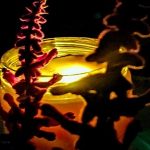Part two of the Sydney Royal Botanic Gardens podcast
During the second part of our tour we learn how Aboriginal people had been managing the landscape for more than 40,000 years.
Paul hunts out one of the many grasses at the botanic gardens known as the kangaroo grass.

One of the many birds having breakfast during our tour.
He explains enthusiastically that, kangaroo grass has a seed and that seed’s been traditionally used and ground up to make a flour to make bread.

And now, recently, archaeologists discovered a grinding stone from a place called Cuddie Springs, and that grinding stone had starch grains from kangaroo grass that was 32,000 years old, which makes Aboriginal people the oldest continuous bread making culture on the planet by 15,000 years.
As we walk through the garden we find ourselves surrounded by plants brought out by the first fleet, and we have tobacco and mulberries and citrus and then directly opposite is that kangaroo grass just coming into seed at the moment.
We quickly learn that when first fleet arrived it was during an El Nino year.

El Niño is a climate cycle in the Pacific Ocean with a global impact on various weather patterns.
The cycle begins when warm water in the western tropical Pacific Ocean shifts and moves eastward along the equator towards the coast of South America.
Normally, this warm water pools near Indonesia and the Philippines.
This can lead to Reduced rainfall.
The shift in rainfall away from the western Pacific, associated with El Niño, means that Australian rainfall is usually reduced through winter–spring, particularly across the eastern and northern parts of the continent. Nine of the ten driest winter–spring periods on record for eastern Australia occurred during El Niño years.
Learn more about what is El Niño and what might it mean for Australia?
http://www.bom.gov.au/climate/updates/articles/a008-el-nino-and-australia.shtml
So, when the first fleet arrived it was a very dry period of time.
And also the soils here are very ancient and very low in nutrients, and the land proved difficult to clear.
They ended up sowing crops between fallen trees and stumps. Due to the low soil nutrition and because of the lack of water, the crop really failed, and they harvested less than they sowed.
And after these various experiments they found better land on the Hawkesbury River, the Parramatta river and the Hunter river, that agriculture really took off on the continent.
Many Scottish people also really built this garden between 1816 and the beginning of the 20th century.

So in this case though, this is a man whose name was Joseph Gerald and Joseph.
Gerald was transported as a convict, and he was convicted essentially of political crimes. He was campaigning for more democratic freedoms for the people of Scotland.
And not coincidentally, the first superintendent of these gardens, the first colonial botanist was also a Scott.
Upcoming events: :
Learn about the diverse history and culture of the Aboriginal people of the Sydney region with an Aboriginal guide in the heart of the city. Uncover the Royal Botanic Garden’s rich Aboriginal heritage by exploring plant uses, culture, artefacts and tasting some bush foods.
Please answer the questions here https://forms.gle/5Sfc28eSXTkux5Bg7
if you cannot see a form below
Join us in part one of our tour of the Royal Botanic Garden Sydney


